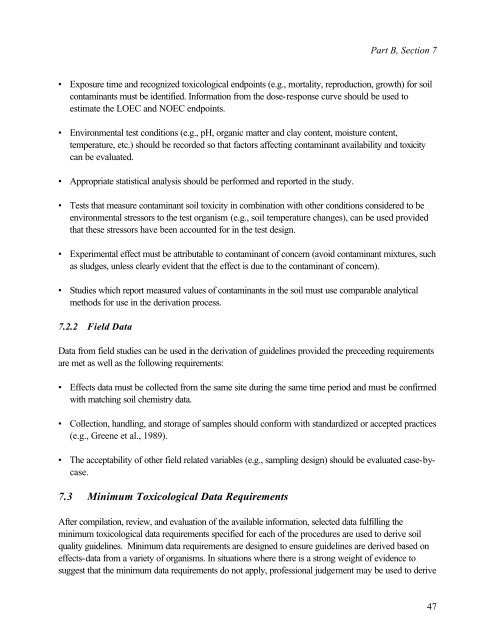Protocol for the Derivation of Environmental and Human ... - CCME
Protocol for the Derivation of Environmental and Human ... - CCME
Protocol for the Derivation of Environmental and Human ... - CCME
Create successful ePaper yourself
Turn your PDF publications into a flip-book with our unique Google optimized e-Paper software.
Part B, Section 7<br />
• Exposure time <strong>and</strong> recognized toxicological endpoints (e.g., mortality, reproduction, growth) <strong>for</strong> soil<br />
contaminants must be identified. In<strong>for</strong>mation from <strong>the</strong> dose-response curve should be used to<br />
estimate <strong>the</strong> LOEC <strong>and</strong> NOEC endpoints.<br />
• <strong>Environmental</strong> test conditions (e.g., pH, organic matter <strong>and</strong> clay content, moisture content,<br />
temperature, etc.) should be recorded so that factors affecting contaminant availability <strong>and</strong> toxicity<br />
can be evaluated.<br />
• Appropriate statistical analysis should be per<strong>for</strong>med <strong>and</strong> reported in <strong>the</strong> study.<br />
• Tests that measure contaminant soil toxicity in combination with o<strong>the</strong>r conditions considered to be<br />
environmental stressors to <strong>the</strong> test organism (e.g., soil temperature changes), can be used provided<br />
that <strong>the</strong>se stressors have been accounted <strong>for</strong> in <strong>the</strong> test design.<br />
• Experimental effect must be attributable to contaminant <strong>of</strong> concern (avoid contaminant mixtures, such<br />
as sludges, unless clearly evident that <strong>the</strong> effect is due to <strong>the</strong> contaminant <strong>of</strong> concern).<br />
• Studies which report measured values <strong>of</strong> contaminants in <strong>the</strong> soil must use comparable analytical<br />
methods <strong>for</strong> use in <strong>the</strong> derivation process.<br />
7.2.2 Field Data<br />
Data from field studies can be used in <strong>the</strong> derivation <strong>of</strong> guidelines provided <strong>the</strong> preceeding requirements<br />
are met as well as <strong>the</strong> following requirements:<br />
• Effects data must be collected from <strong>the</strong> same site during <strong>the</strong> same time period <strong>and</strong> must be confirmed<br />
with matching soil chemistry data.<br />
• Collection, h<strong>and</strong>ling, <strong>and</strong> storage <strong>of</strong> samples should con<strong>for</strong>m with st<strong>and</strong>ardized or accepted practices<br />
(e.g., Greene et al., 1989).<br />
• The acceptability <strong>of</strong> o<strong>the</strong>r field related variables (e.g., sampling design) should be evaluated case-bycase.<br />
7.3 Minimum Toxicological Data Requirements<br />
After compilation, review, <strong>and</strong> evaluation <strong>of</strong> <strong>the</strong> available in<strong>for</strong>mation, selected data fulfilling <strong>the</strong><br />
minimum toxicological data requirements specified <strong>for</strong> each <strong>of</strong> <strong>the</strong> procedures are used to derive soil<br />
quality guidelines. Minimum data requirements are designed to ensure guidelines are derived based on<br />
effects-data from a variety <strong>of</strong> organisms. In situations where <strong>the</strong>re is a strong weight <strong>of</strong> evidence to<br />
suggest that <strong>the</strong> minimum data requirements do not apply, pr<strong>of</strong>essional judgement may be used to derive<br />
47
















